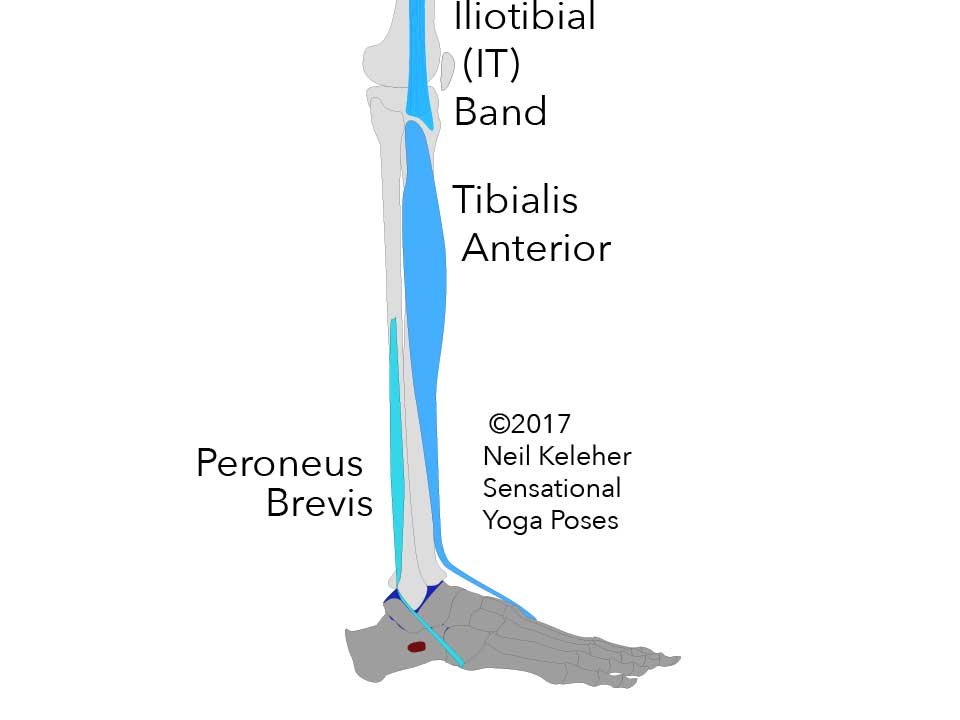Peroneus Brevis
Anchoring the fibula, stabilizing the outer arch of the foot
Peroneus Brevis, like Peroneus Longus, attaches to the outside of the fibula. It attaches to the lower portion of the fibula, nestled between the fibula and peroneus longus.
When active it can be used to help create a downwards pull on the fibula thus helping to anchor the biceps femoris. Or it can be used to help stabilize the outer arch of the foot.
If the outer edge of the foot, in particular the forefoot, is bearing weight, and the inner arch is lifted, then peroneus brevis can work from the outer edge of the foot to create a rearwards pull on the bottom of the fibula.
Like the peroneus longus, the tendon of the peroneus brevis passes downwards behind the lateral malleosus, the "bump" at the side of the ankle. It passes down the outside of the calcaneus, angling forwards and downards so that it passes in front of the trochlear process.
The trochlear process is a squarish shaped projection located on the outside surface of the calcaneus or heel bone.
Diverging from the Peroneus Longus
Where the lower tendon of the peroneus longus passes behind the trochlear process and from there proceeds to wrap beneath the foot at the cuboid bone, the peroneus brevis passes in front of the trochlear process, and from there along the outside of the cuboid and then attaches to the outer edge of the outermost metatarsal.
The outermost metatarsal forms the first isolated bone of the little toe.
Outer Arch Support
Where the peroneus longus may create an upwards and rearwards pull on the cuboid, assuming a standing position where weight is on the foot, the peroneus brevis creates a rearwards pull on the outermost metatarsal. Both muscles acting together can help reinforce the arch of the outer foot.
Grounding the Outer Edge of the Foot
Assuming an active tibialis posterior, an active peroneus longus and peroneus brevis can work together to help stabilize the outer edge of the foot. In turn they can create a downwards pull on the fibula, helping to anchor it.
Since the biceps femoris attaches to the top end of the fibula, the above mentioned co-activation of the peroneus brevis can help to provide a stable anchor for the biceps femoris.
Creating a rearwards pull on the bottom of the fibula
If the foot in question is bearing weight and the shin is rotated outwards so that the arch lifts, body weight can be directed towards the outside of the forefoot and onto the base of the outermost metatarsal. This action can thus anchor the end of the peroneus brevis that attaches there.
With the shin rotated outwards and the inner arch lifted, this tends to cause the lateral malleosus (the bottom of the fibula) to rotate rearwards. Thus the peroneus brevis can act to create a rearwards as well as a downwards pull on the fibula.
This particular action can be helpful in high load situations (squatting with weight, deadlifting) for preventing the inner arch from collapsing.
Unweighted Activation of the Peroneus Brevis
With the foot unweighted, say while sitting in staff pose with the feet straight out in front, activation of the peroneus brevis may help to pull the outer edges of the feet rearwards, towards the hips.
In a pose like pigeon pose, with the front leg hip on the ground, activation of the peroneus brevis may help to stiffen the outer edge of the foot making it easier to "Press" the outer edge of the foot into the ground.
Published: 2020 08 05



